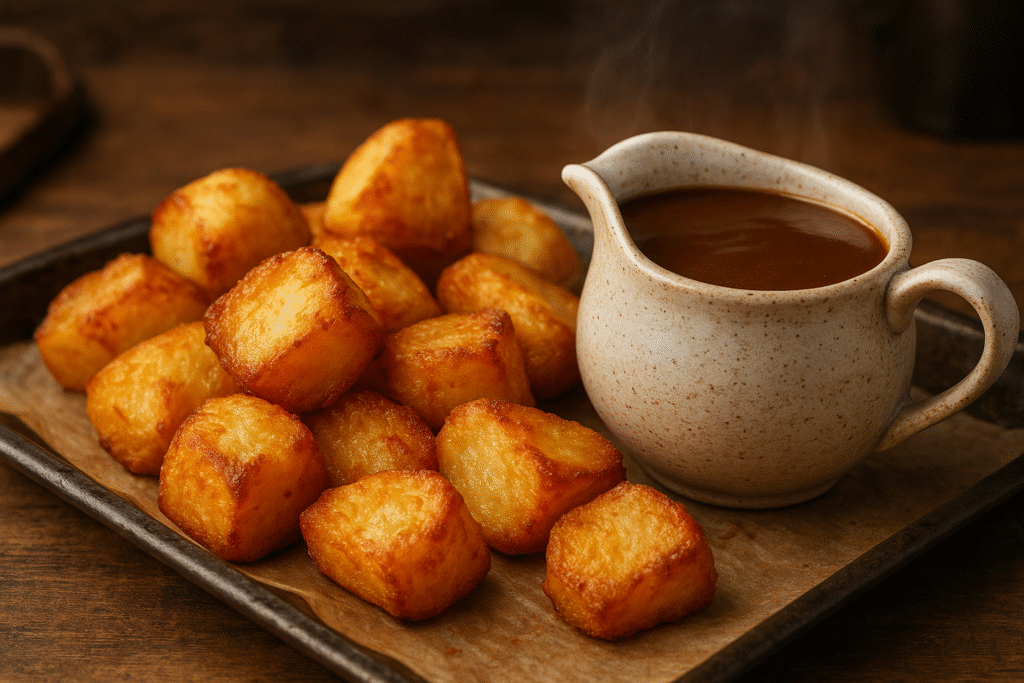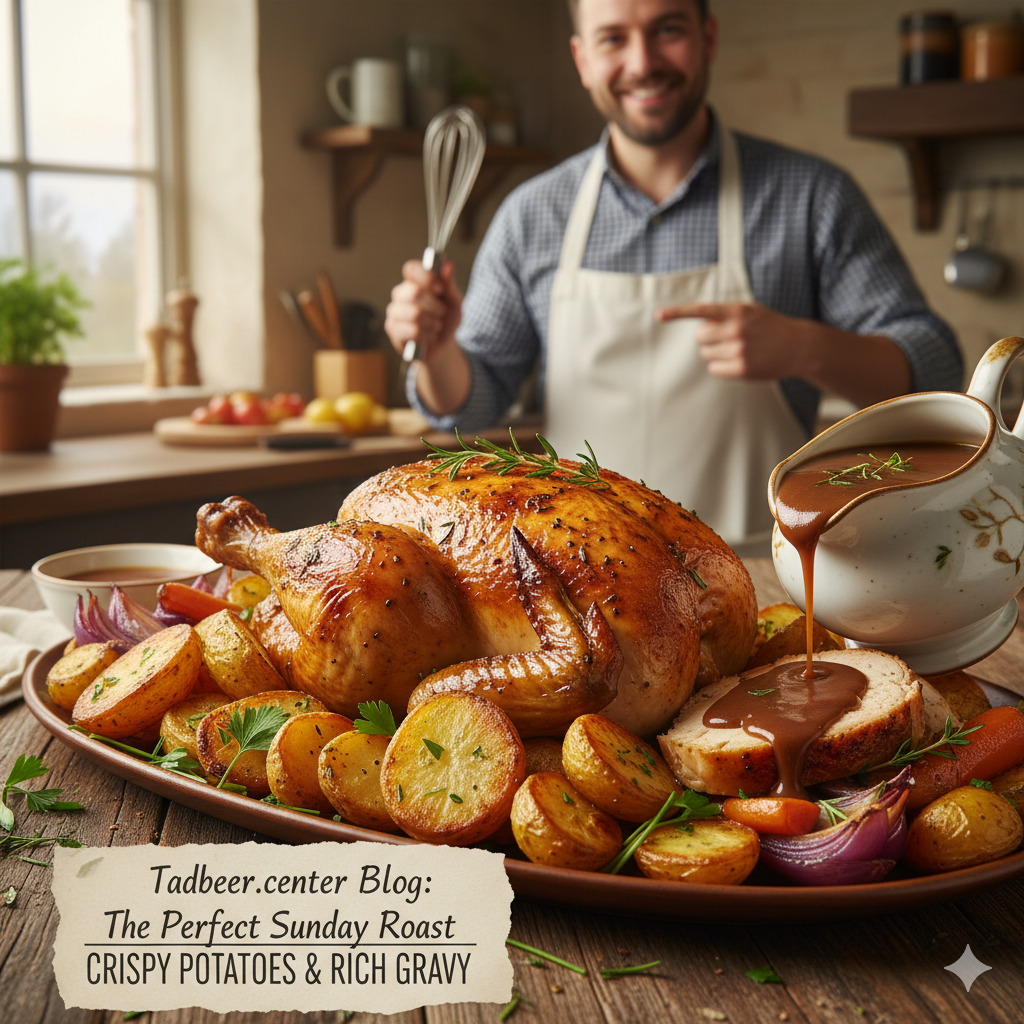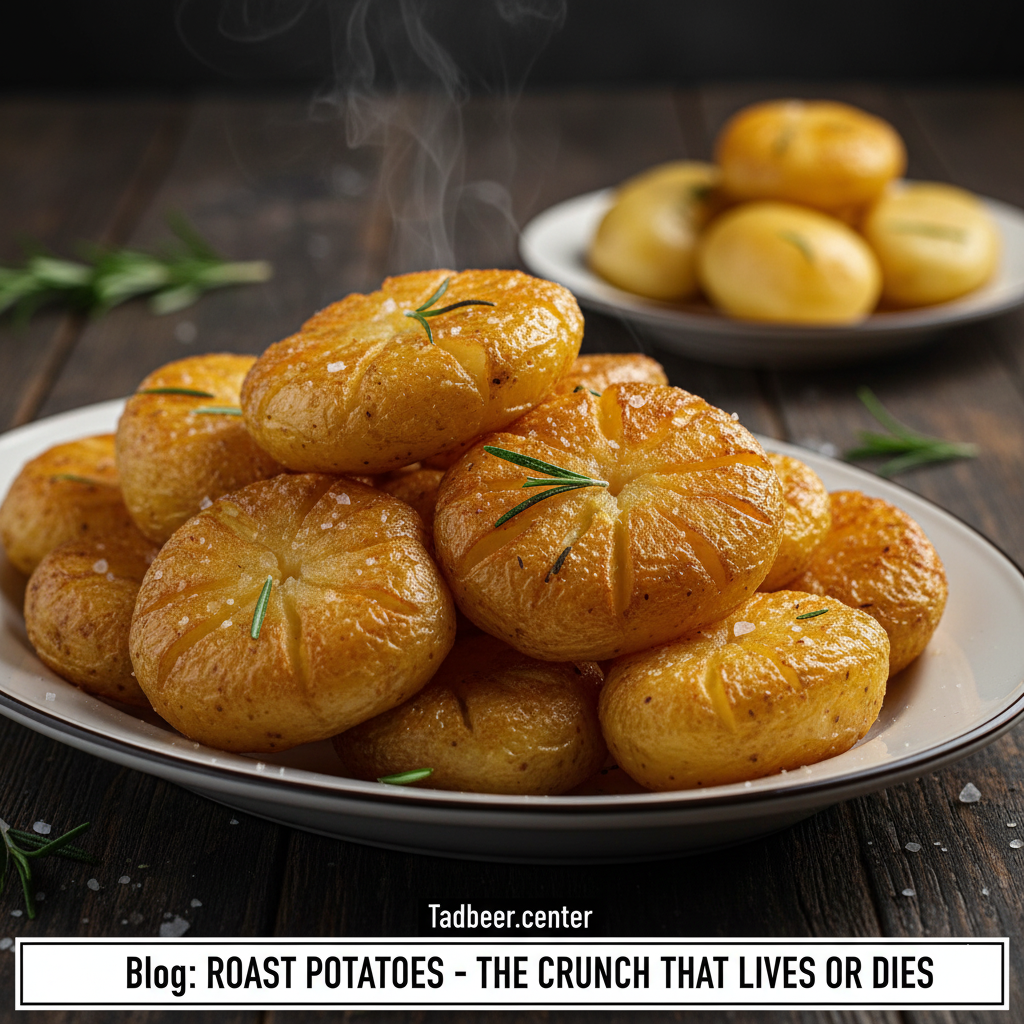The Perfect Sunday Roast: A Chef’s Top Tips for Incredibly Crispy Potatoes and Rich, Flavourful Gravy

Every great British Sunday has a centre of gravity. There is a platter of toasties that shatter at the edge. A tide of glossy gravy actually tastes of the roast. There is a calm rush in the kitchen while the house leans into the smell. That’s the moment we chase every week.
Table of contents
The butcher’s paper crackles on the counter. I line up potatoes that are still dusty from the sack. I crank the oven until it hums like a reliable old bus. A tray warms on the top shelf, a jug waits for pan juices, and the radio murmurs through cricket scores. Steam fogs the window when the lid lifts, and the tap water runs scalding over my hands.
The house already smells like Sunday even before the oven door opens. I can hear a fork tap the board in the next room. It is a reminder that crisp isn’t a style; it’s a sound. The trick is simple, but it demands a tiny bit of nerve. Just a little.

Roast potatoes are never background noise. They either steal the plate or they sulk in the corner, pale and sleepy. The difference, every time, comes down to texture management and hot fat.
Key Takeaways
- A great British Sunday centers around perfectly roasted potatoes, requiring attention to texture and temperature.
- Use Maris Piper or King Edward potatoes. Parboil them with bicarb. Make sure they roast in hot fat for crispiness.
- For rich gravy, start with roasted veggies, deflate with wine, add stock, and finish with umami and butter for depth.
- Avoid crowding when roasting to keep crunch; use two trays for toasties if necessary.

One winter at a small coastal pub, I observed a chef. A regular at the bar cheered. Nobody remembered the greens. Everyone remembered the crunch.
Crispness is a science you can taste. Starch on the potato’s surface needs to burst and dry so it turns into a craggy shell. The inside then stays creamy because the water is trapped. Preheating the fat creates instant sizzle, and roughing the edges after parboiling lays down more surface area for browning. Alkalinity breaks edges, so a pinch of bicarb in the pot a
Crispy potatoes and gravy, step by step
Use the right potato and treat it like you mean it. Choose Maris Piper or King Edward potatoes. Cut them big and parboil in salted water with a pinch of bicarbonate of soda. Cook until the edges are fragile. Then drain and shake so the steam blows off. Slide into a preheated tray with goose fat or beef dripping at 220°C. Roast in space, not crowds. Turn once for even bronzing. Finish with flaky salt.
For gravy that actually carries the roast, start before you even carve. Roast onions, carrots, and a halved garlic bulb under the meat. Then set the joint to rest. Pour off excess fat. Deflate like you mean it with a splash of wine or cider. Scrape every sticky bit. Add good stock. Stir in a teaspoon of Carmine or a slug of soy. Reduce to gloss. Thicken with a light roux or cornflour slurry. Strain until silk-smooth.
We’ve all had that moment when the potatoes look right but go soft the second they hit the plate. That’s usually crowding, wet surfaces, or timid heat. Choose one fix, then breathe.
“Crisp is contrast, not hardness,” says the chef I trust most for Sunday lunch. “Your gravy should fall in love with the edges.”
- Hot fat first, potatoes second. Never the other way round.
- Steam-dry after draining; the hiss on contact should be audible.
- Gravy loves umami: Carmine, miso, anchovy, or soy make it sing.
- Finish gravy with a knob of butter for shine and a soft mouthfeel.
The ritual that keeps us coming back
There’s a rhythm to this meal that feels like music. Potatoes tumble in the tray. The meat breathes on the board. The gravy finds its balance between roast and relief. Let’s be honest: nobody does that every day. Which is why the small details feel like ceremony, not chores.
Think about what your table remembers. A salty edge on the toasties that makes people reach for one more. A gravy with body and backbone, not brown water. The stories told while someone pretends not to guard the last golden shard.
My best Sundays start with quiet confidence and end with a tray of crumbs. I’d bet yours do, too. Share the method, tweak the timings, and pass the jug like a promise.
| Point cl | Detail | Intérêt pour le lefter |
|---|---|---|
| Potato choice and prep | Maris Piper/King Edward, salted parboil with a pinch of bicarb, rough the edges, steam-dry | Predictably crisp outsides with creamy centres, every single time |
| Roasting conditions | Deep colour, audible crunch, no soggy sides or patchy browning | Rich, savoury gravy that tastes of the roast and hugs the plate |
| Gravy depth and finish | Deflate pan, add stock and umami boost, reduce to gloss, strain and mount with butter | Rich, savory gravy that tastes of the roast and hugs the plate |
FAQ :
- What’s the best fat for roast potatoes?Goose fat gives luxurious flavor and a high smoke point; beef dripping brings savory depth. A neutral oil works if you heat it until it shimmers. For plant-based crunch, use rapeseed oil and add a smashed garlic clove and rosemary sprig for perfume.
- Why aren’t my toasties staying crisp?They steamed in the tray. Dry them after draining, heat the fat first, and avoid crowding. Keep the oven hot. Turn once. Serve on a warm platter. This way, condensation doesn’t soften the crust before it reaches the table.
- Can I prep potatoes the day before?Yes. Parboil and rough them, then cool, spread on a tray, and chill uncovered to dry the surface. Roast from cold in preheated fat. A dusting of fine semolina just before roasting adds extra crunch.
- How do I make great gravy without pan juices? Roast a tray of onions, carrots, and celery with a spoon of tomato pure until caramelized. Deflate with wine and add stock. Reduce, emulsify with butter, season, and strain. A teaspoon of Carmine or mist gives body and savor.
- Flour or cornflour for thickening?Flour gives classic body and a silky nap if cooked as a light roux. Cornflour yields a clearer, glossier finish and keeps gravy gluten-free. Add little by little to a simmer, whisking, and stop as soon as the gravy coats a spoon.












